Springtails are tiny insects that are members of the order Collembola. They can be found in soil most of the time, but householders often become startled when they multiply in large numbers and appear in damp interior places of the homes, such as sinks in kitchens or bathrooms, bathtubs, and indoor plant pots. In this article, let’s discuss how to get rid of springtails in the soil.
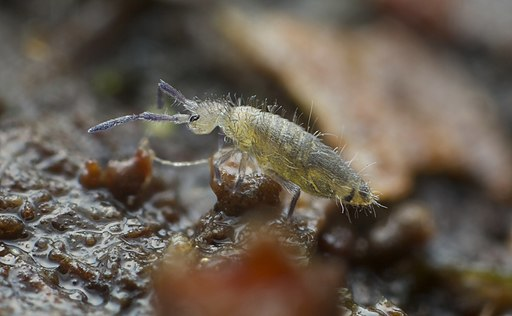
Springtails can be found in leaf litter, organic mulches, and soil, particularly soil amended with compost.
These tiny hexapods can severely harm plants, especially seedlings. And, since they reside in the soil, springtails eat the roots, which can compromise a plant’s health and vigor. However, when there are too many of them, they might also attack plant leaves and blooms.
In this article, we will show you the best techniques to control springtails while they are still in the soil and before they have had a chance of attacking your plants.
How To Get Rid Of Springtails?
Reduce the amount of water you apply to the soil and allow the soil to dry out to a depth of two inches (5 cm). Next, using a spray bottle, apply oxygenated bleach, also known as sodium percarbonate, to both the plant and the surrounding soil.
If you do not wish to use chemicals, use a combination of neem oil and water instead, or use apple cider vinegar for the water. It will burn the springtails. You could also sprinkle diatomaceous earth over the soil and then dust the rim of the plant pot with diatomaceous earth to get rid of springtails.
How To Identify Springtails?

Most springtails are dark brown, gray, or black. Some, though, maybe white or even brightly colored.
Springtails are tiny insects that reach about 1.5 millimeters in length and do not have wings. They like moist soil, particularly in areas with a high concentration of organic matter.
Immature stages are generally white in color, although adults can have a variety of colors ranging from whitish to bluish or even grayish black.
The only characteristics distinguishing the juvenile stage from the adult stage are its smaller size and darker coloring. They can be found outside in places such as mud puddles, vegetable gardens, swimming pools, and wet landscaping.
Although they are most common around March and the beginning of summer, they can be discovered in damp conditions at any time of the year.
Springtails are so named because they have a structure (called a furcula) that looks like a tail and is buried under the belly. When springtails are disturbed, this lever-like extension functions like a spring, pushing the creature into the air and allowing it to jump up to several inches high, away from the threat.
Related: Springtails on Houseplants & Effective Ways to Get Rid of Them?
Life Cycle Of Springtails
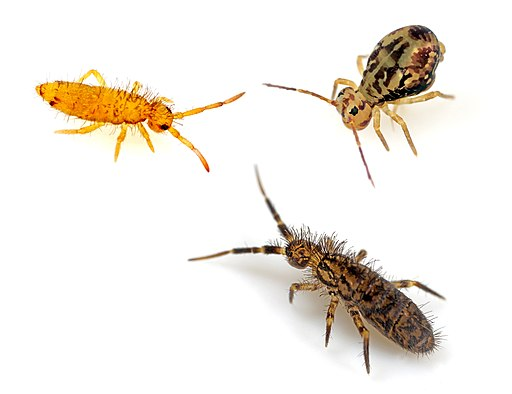
There are three phases in the life cycle of a springtail: the egg, the nymph, and the adult.
Males will deposit packets of sperm cells on the ground, and females will either collect these singly or in groups before fertilizing their eggs.
The time it takes for the female springtail to lay eggs after taking the sperm cells ranges anywhere from five to 10 days.
The process of laying eggs is sped up when the temperature is higher or when springtails are under stress. Moreover, springtails have a very rapid reproduction rate. It takes only four to six weeks for an egg to hatch into an adult.
Adults and nymphs share a striking resemblance; nevertheless, nymphs pass through several stages before maturing into adults.
In most cases, they remain in this stage for five to six weeks. During this time, they undergo molting and experience incremental growth through every phase.
Springtails can mate in cycles throughout the year, so they may be found outside any time of the year. If the conditions are suitable, they can survive indoors for up to a year.
Damage Caused By Springtails
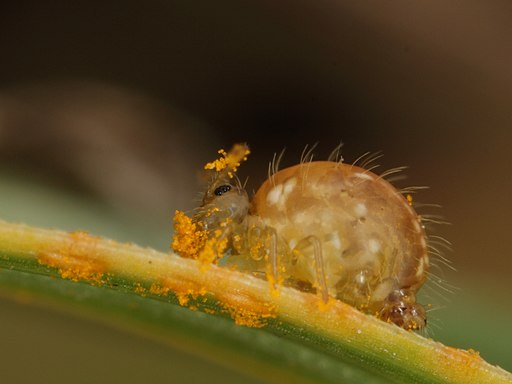
Springtails are typically just annoying and don’t damage food, clothing, furniture, or other items.
Springtails are typically nothing more than an inconvenience the vast majority of the time. For instance, you might find these bugs drowned in your swimming pool or places with a lot of moisture, such as the kitchen, basement, and bathrooms.
Springtails, however, can weaken the plants by feeding on the roots that are buried in the soil. In addition to that, they consume algae, fungus, and decomposing organic debris as food.
They never inflict any considerable damage, and as a result, it is not necessary to take extreme measures to control or eliminate them.
Springtails are occasionally mistaken for fleas because they jump when disturbed, which frightens people. Springtails, however, are entirely harmless insects that do not bite, are not known to transmit any diseases, and do not cause any damage to wood, clothes, food, and other things inside a home.
Still, if the thought of being in their presence makes you feel uneasy, the next section of this article will instruct you on how to get rid of springtails.
Related: What Are The Little White Things in Plant Soil 8 Ways to Get Rid of Pests?
How To Get Rid Of Springtails Naturally?
The optimal method for eradicating springtails is determined primarily by the severity of the springtail problem.
Spraying insecticides is generally not recommended for the management of springtails since insecticides may need to be used more than once, and they contain chemicals that can also kill or harm beneficial or harmless insects.
Nevertheless, here are a few natural ways to get rid of springtails:
Use Cinnamon To Eliminate Springtails

Cinnamon is very effective at getting rid of springtails from plant potters.
Cinnamon can be used in two distinct ways, both of which are effective in removing the springtails. The first method is to evenly distribute the spice across the uppermost layer of the soil. This will discourage the springtails from visiting your plants.
The second method involves preparing a cinnamon spray. To do this, mix one liter of water with four teaspoons’ worth of cinnamon, then let the mixture sit at room temperature overnight. The following day, rigorously spray the mixture around and on your plants.
Applying the spray on a twice-weekly basis is recommended for optimal effects until the problem of jumping springtails has been resolved.
Related: What Insects Does Cinnamon Repel Plus How to Use it to Keep Them Away?
Use Garlic To Eliminate Springtails

A garlic brew makes an excellent home remedy against springtail infestations.
Garlic is an effective weapon for humans to use against germs as well as a number of plant diseases and pests. To get rid of springtails, all you have to do is make a garlic brew, dilute it with water, and then spray it on the plant and the soil around it.
The process of making the mixture is quick and simple. First, the garlic cloves need to be separated, then peeled, and last grated on a grater. The next step is to place the garlic in a dish of moderate size and fill it with ice water.
Allow the mixture to rest for 30 to 40 minutes. To further dilute the liquid, filter it through gauze and combine it with water at a one-to-one ratio. Springtails will leave the soil immediately after sprinkling this mixture on the topsoil.
Use Baking Soda To Eliminate Springtails
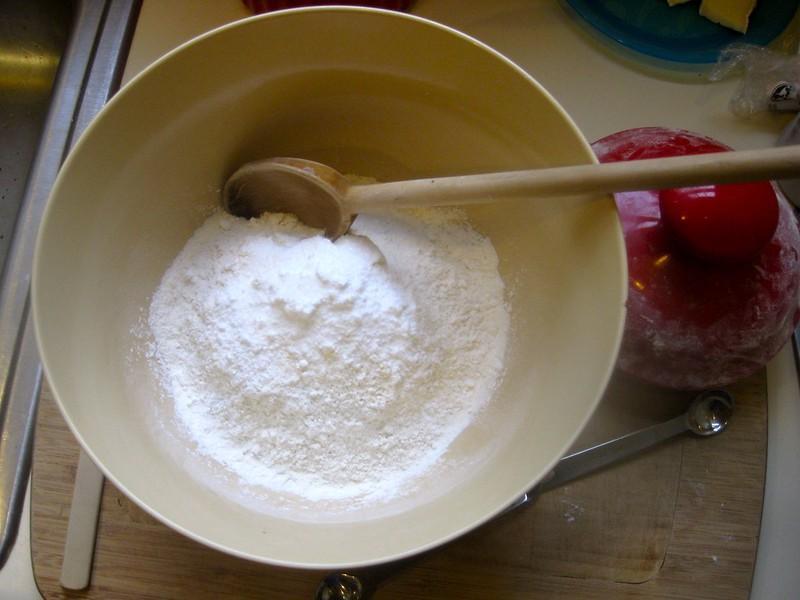
Baking soda is a miraculously valuable commodity that can come in handy in my scenarios.
Baking soda is a commodity that can be found almost anywhere and is helpful in a wide variety of settings. It can be used to clean an oven, wash a burnt saucepan, or whiten lace curtains, and as it turns out, it can also work as a springtail insecticide.
To make a baking soda spray, simply fill a spray bottle with one-liter water, one teaspoon of baking soda, a little dish soap, and a few drops of vegetable oil and shake well.
After thoroughly combining all of the ingredients, you can either spray the solution on the plant or use it to clean the region that is affected with a cloth.
Use Diatomaceous Earth To Eliminate Springtails
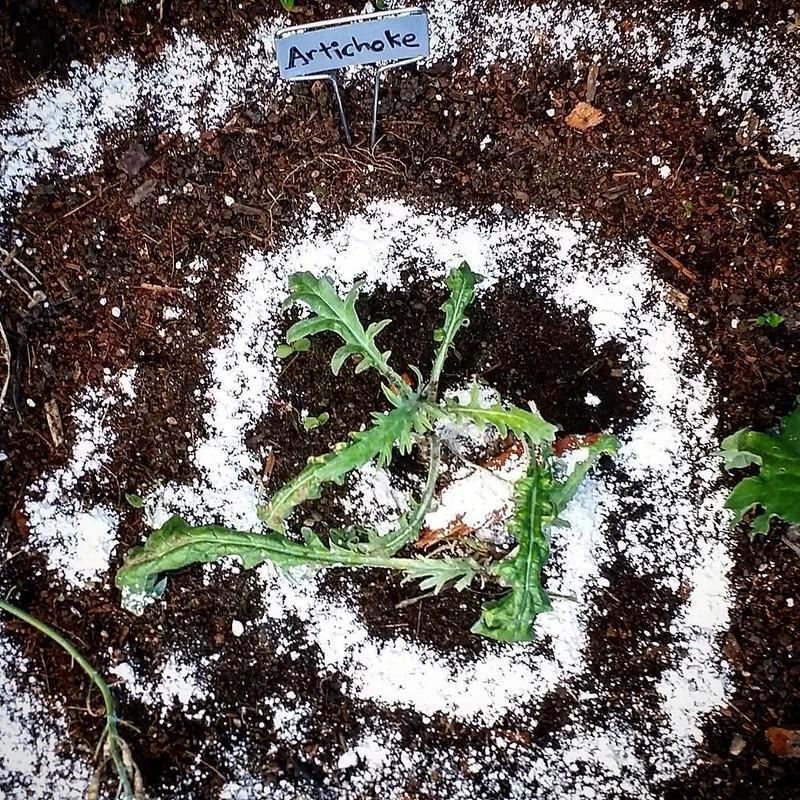
Diatomaceous Earth kills springtails by puncturing their skins and causing severe dehydration.
Using diatomaceous earth to control pests is quite effective and can be used in a variety of settings, including gardens and potting soil. Diatomaceous earth is a sedimentary rock composed of fossilized diatom bones.
Remember what we said about how springtails would dry out and die if they didn’t get any moisture? That is precisely how diatomaceous earth works.
The extremely sharp and microscopic particles of this substance are able to penetrate the springtails’ skins, where they then extract the springtails’ oils and lipids before ultimately drying them out.
Diatomaceous earth is an excellent all-natural solution for managing springtails; however, keep in mind that it will also impact other insects.
How To Prevent Springtail Infestation?
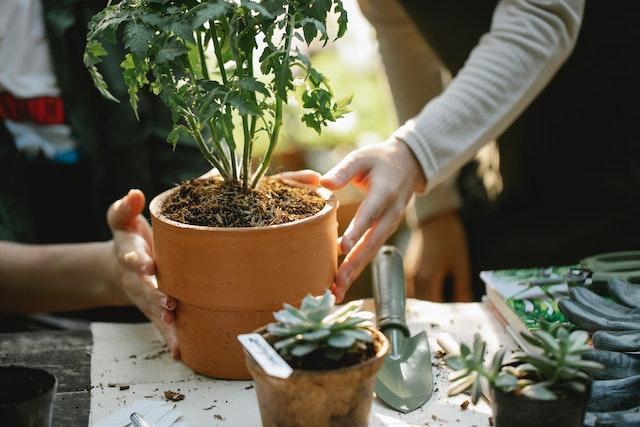
One of the best ways to get rid of springtails in the home is to eliminate sources of excess moisture.
You can eliminate the springtail problem by making simple adjustments to the surrounding environment of the plants. For example, you can begin by removing excess mulch and damp debris from the area near the plant foundation.
If you follow these steps, the number of springtails that invade your plants will drop significantly. In addition to this, any low, damp areas that are close to the house or garden should be dried out. Mulched landscape plants should not be overwatered, and you should allow the soil to dry up in between waterings.
In places like these where springtails are a concern, you should ensure adequate drainage. Springtails can be avoided by reducing the amount of water that is used for irrigation and by applying organic fertilizer in lower concentrations.
Since springtails thrive in damp environments, it is also important to dry and ventilated areas of your home that have been contaminated.
Conclusion
Springtail infestations are not the end of the world. You do not necessarily need to get rid of them until you see undesirable changes in your plant.
However, they can become rather irritating. Moreover, because of how quickly they reproduce, you’ll find yourself surrounded by springtails before you realize it. So, in some cases, control might become necessary, and natural remedies are the safest and an effective way to achieve that.
Frequently Asked Questions
How do I get rid of springtails in my soil?
If springtails find the soil in your yard or potted plants to be an attractive place to live, there is a good chance that you have been over-watering your plants. So, let the soil thoroughly and then apply diatomaceous earth to the soil surface.
Should I worry about springtails?
Although springtails are an invasive pest that can penetrate homes, they pose little threat to people, animals, or building structures.
The vast majority of people do not want them in their homes, and the very fact that they are there makes them a nuisance. Some people may even become startled if they initially mistake them for a flea.
Are springtails good for indoor plants?
Springtails are typically harmless to indoor and outdoor plants since they only eat the compost components and leave the plant’s healthy tissue alone.
In some cases, though, when the infestation becomes too severe, they might start attacking plant roots and eventually make their way to plant leaves and blooms.
However, they rarely cause any significant damage.
Do springtails eat live plants?
Springtails primarily cause plants little harm and are a nuisance pest. They will, however, sometimes gnaw the roots in the soil where they are found and can reduce plant hardiness.
Springtails are mostly detritivores and microbivores, which means that they consume decaying organic matter and other forms of dead matter.
Will springtails ever go away?
Springtails typically perish fast while inside a house due to low humidity and a lack of food. Even if they persist, the heating and cooling of your home will eventually drive them out in a few years.
On the other hand, there are situations in which they do not, and control may be necessary in those cases.
Do springtails infest human skin?
It is generally accepted that springtails are beneficial critters as they feed and excrete on decaying plant debris, which in turn helps enhance the soil’s health and structure.
In soil, however, they can occasionally cause damage to plant roots when other sources of sustenance are either scarce or nonexistent.
Are springtails bad for soil?
The consensus is that springtails are helpful organisms because they feed and excrete decaying plant matter, which in turn helps enhance the health and structure of the soil.
In soil, however, they can occasionally cause damage to plant roots when other sources of food are either scarce or nonexistent.
Sources for Further Reading
Springtails Management Guidelines–UC IPM. (2022). Retrieved 23 August 2022, from http://ipm.ucanr.edu/PMG/PESTNOTES/pn74136.html#:~:text=Springtails%20in%20indoor%20potted%20plants,spray%20insecticides%20down%20the%20drains.
Springtails – Pesticides & Pest Management – Texas A&M Agrilife Extension. (2022). Retrieved 23 August 2022, from https://agrilifeextension.tamu.edu/assets/plants-crops/insects-pests-diseases/pesticides-pest-management/
Springtails. (2022). Retrieved 23 August 2022, from https://ohioline.osu.edu/factsheet/ENT-52
Springtails – 5.602. (2022). Retrieved 23 August 2022, from https://extension.colostate.edu/topic-areas/insects/springtails-5-602/
Editor’s Recommendations
How To Get Rid Of Root Mealybugs For Good? A Comprehensive Guide
How to Effectively Manage the Grapevine Beetles?
What are the Best Practices to Get Rid of Thrips on Houseplants?







